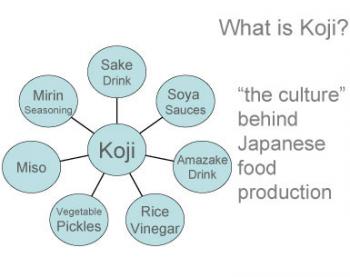Koji
Koji is not actually a yeast, as many people mistakenly believe. Koji is cooked rice and/or soya beans that have been inoculated with a fermentation culture, Aspergillus Oryzae. This naturally occurring culture is particularly prevalent in Japan, where it is known as koji-kin, which explains why so many Japanese foods have been developed over the centuries using it. It is used to make popular foods like soya sauce, miso, mirin and sake.
The first step in making these products is creating the koji. This involves adding the Aspergillus culture to steamed rice or soya beans or, in the case of shoyu soya sauce, to a combination of steamed soya beans and roasted, cracked wheat. The resulting mixture is then placed in a warm and humid place for up to 50 hours, often in wooden trays called koji buta in Japanese. During this time the Aspergillus feeds on the rice or soya beans, using enzymes that are adept at breaking down carbohydrates and proteins.
Special Precautions of Koji
Benefits and uses of Koji are
The amino acids, fatty acids and simple sugars released by the action of the koji add flavour, depth and, it has been argued, a number of health benefits to foods.
- Miso : The fermentation of soya beans using koji to create miso is known to increase the levels of isoflavones, which are compounds that are said to be effective in the prevention of cancer.
- Amazake
